| Columns Retired Columns & Blogs |
Holy smokes! that is a beautiful beast. I'll take it!
To take these measurements, I used Stereophile's loan sample of the top-of-the-line Audio Precision SYS2722 system (see the January 2008 "As We See It" and www.ap.com). Before doing the testing, I ran the Musical Fidelity AMS100 at one-third its rated power for 60 minutes, which thermally is the worst case for an amplifier with a class-A/B output stage. However, an amplifier with a class-A output stage runs cooler when under load. At the end of that period, the chassis was warm, with a temperature of 104°F (40°C), though the heatsinks were hotter, at 116°F (46.6°C). Without any signal fed to the amplifier, the heatsink temperature slowly rose to 120°F (48.6°C). The AMS100 is not an amplifier you can hide in a closet—even if you have a closet big enough.
The voltage gain was the same for both balanced and unbalanced inputs, at 29.9dB, which is 3dB higher than the US norm. Both inputs preserved absolute polarity (ie, were non-inverting), the XLRs being wired with pin 2 hot. The input impedance was close to specification at low and middle frequencies, at 48k ohms unbalanced and balanced for each leg, but dropped at 20kHz to 39k ohms balanced and 17k ohms unbalanced.
The AMS100's output impedance (including 15' of speaker cable) was low across most of the audioband, at 0.08 ohm. However, this rose to 0.22 ohm at 20kHz, which restricts the amplifier's bandwidth into lower impedances. While the small-signal frequency response is down by just 0.17dB at 20kHz and by 3dB at 170kHz (fig.1, blue and red traces), it is –0.5dB at 20kHz into 4 ohms (cyan and magenta traces) and –0.9dB at 20kHz into 2 ohms (green trace). However, the variation of the response with our standard simulated loudspeaker was minimal, at ±0.1dB (gray trace). The wide bandwidth into 8 ohms gives rise to a well-formed 10kHz squarewave, with neither overshoot nor ringing evident (fig.2). The 1kHz squarewave (fig.3) was equally well-formed.
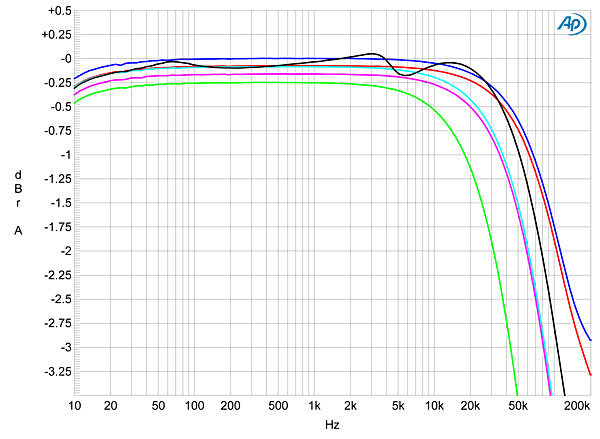
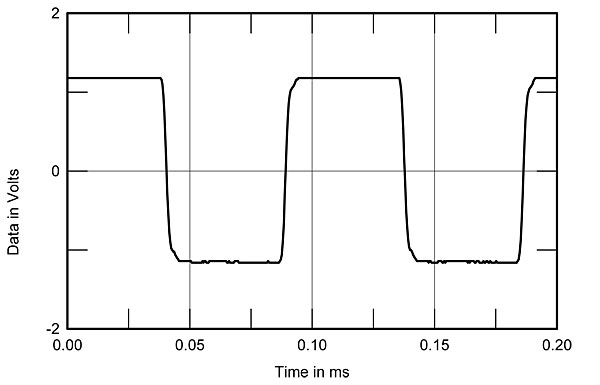
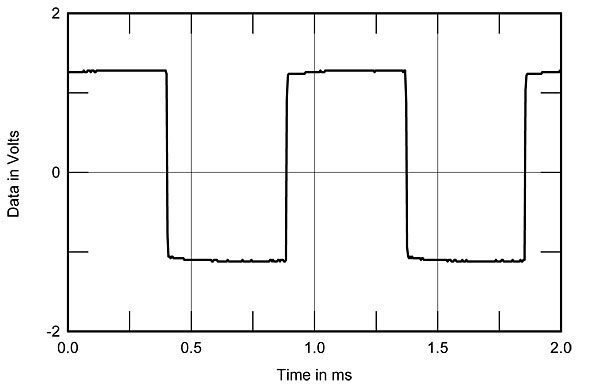
Channel separation (not shown) was excellent at >100dB below 800Hz in both directions, and was still 80dB at 20kHz. The unweighted wideband signal/noise ratio was not as good as I was expecting from a class-A design, at 76.8dB left and 75.3dB right, both figures ref. 1W into 8 ohms. A-weighting improved the ratios to a respectable 89.2 and 90.75dB, respectively. Fig.4 reveals that the AMS100's low-frequency noise floor has some supply-related spuriae: the tones at 120 and 240Hz stem from the full-wave supply and are a little higher in the right channel than the left; those at 60 and 180Hz and higher may well be due to magnetic leakage from the massive power transformers into the chokes used to smooth the DC voltage rails. Nevertheless, all these spuriae lie at better than –120dB ref. maximum power, and so should be inaudible.
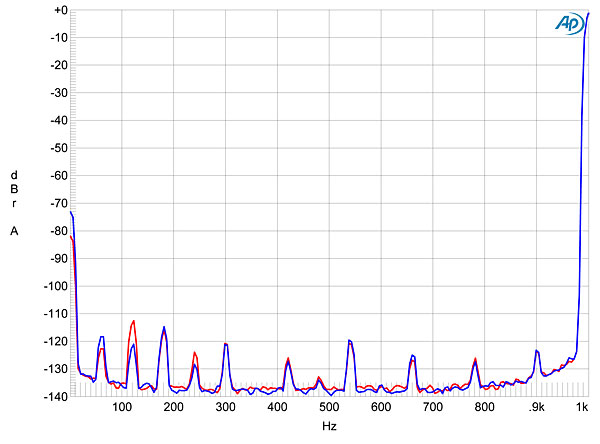
Figs.5, 6, and 7 plot the percentage of THD+noise in the Musical Fidelity's output against output power into 8, 4, and 2 ohms, respectively. We define clipping as the power level at which the THD+N reaches 1%; these graphs confirm that the AMS100 meets its 100Wpc (20dBW) specification into 8 ohms, but clips at 185Wpc into 4 ohms (19.7dBW). It also clips at 295Wpc into 2 ohms (18.7dBW). I don't hold the wall voltage constant for these tests; it was 120.2V AC with the amplifier quiescent, dropping slightly to 120.1V at clipping into 4 ohms with both channels driven or into 2 ohms with one channel driven. The downward slope of the traces in these graphs suggests that the actual distortion is buried under the noise floor right up to the point where the waveform begins to square, so I plotted how the THD+N percentage changed with frequency at 20V output, which is equivalent to 50W into 8 ohms, 100W into 4 ohms, and 200W into 2 ohms. The results are shown in fig.8—the distortion is very low, at <0.001% at low and middle frequencies into the higher impedances, but it does rise above 1kHz, due to the usual reduction in negative feedback that results from the circuit's restricted open-loop bandwidth. Even so, it is still just 0.011% at 20kHz.
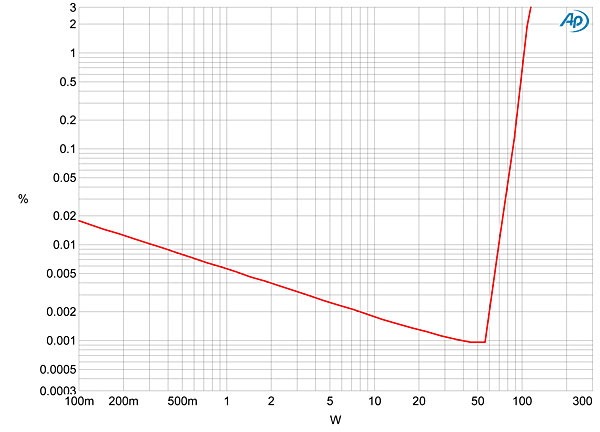
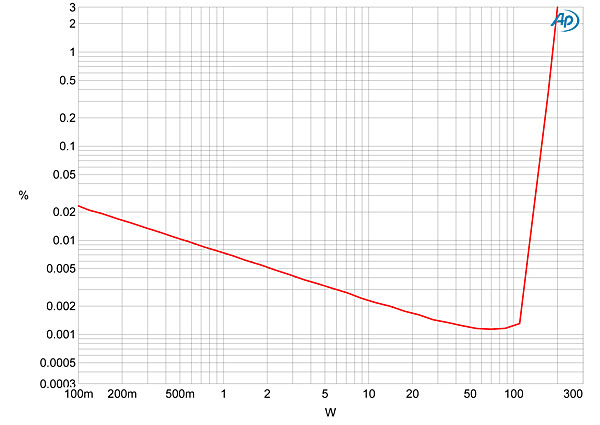
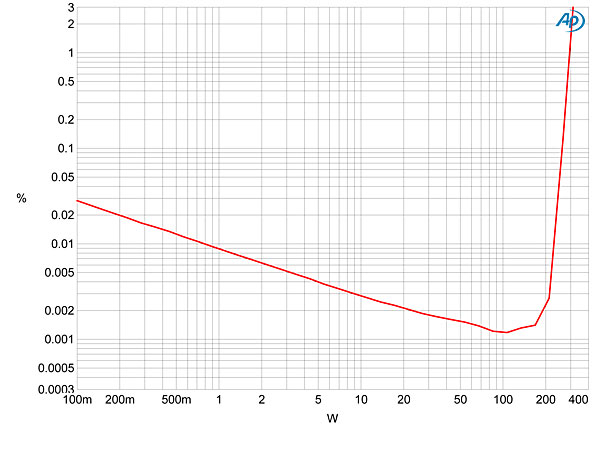
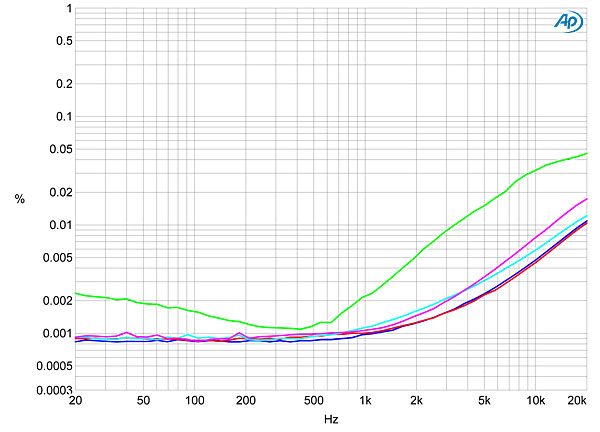
I averaged 64 readings to examine the waveform of the THD+N spuriae, but even then, what appears to be mainly third-harmonic distortion is overlaid with noise (fig.9). FFT analysis (fig.10) confirms that the subjectively innocuous third harmonic is predominant—if anything at –106dB (0.0005%) can be called "predominant." High-frequency intermodulation distortion at the same peak signal level was also very low (fig.11), though it did begin to rise with even a small increase in power (fig.12) or decrease in load impedance.
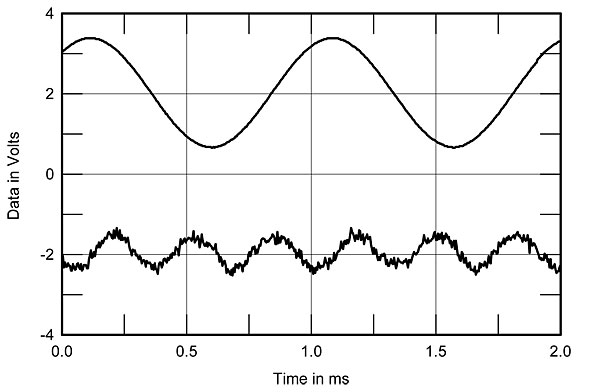
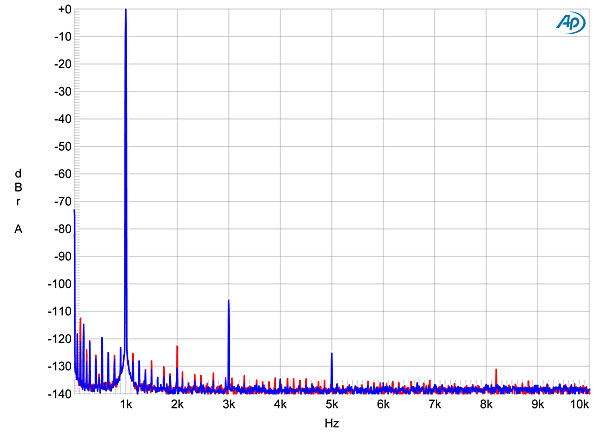
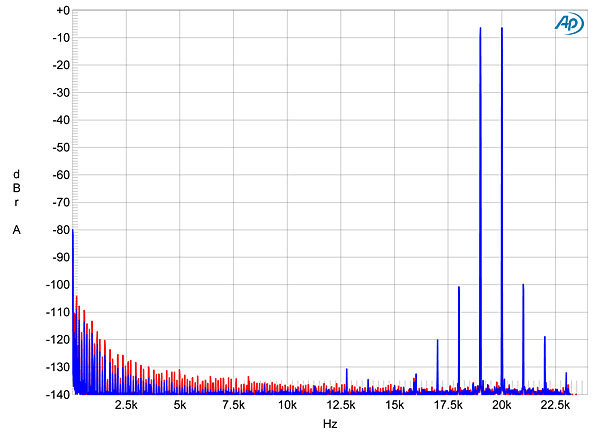
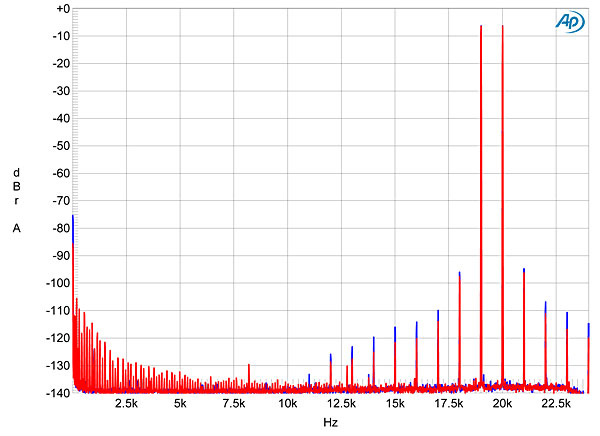
Like other Musical Fidelity power amplifiers, the AMS100 offers excellent measured performance, especially very low static distortion. But the use of class-A bias for its output stage means that its impressive bulk conceals power delivery that is relatively modest when compared to that of its siblings.—John Atkinson

I'll take it!
You won't be able to lift it :-)
John Atkinson
Editor, Stereophile

No doubt John. Geez, where did they pack in all that weight? Couldn't be the chassis alone. Or, could it?
Nevertheless, I can envision hefting that behemoth up the front steps... with the Ambulance arriving shortly thereafter. :-)
Mark

Geez, where did they pack in all that weight? Couldn't be the chassis alone. Or, could it?
4 power transformers + 4 bifilar-wound chokes = "Heavy Iron"
But all that for 100Wpc = equally heavy silliness!
But it did sound gorgeous.
John Atkinson
Editor, Stereophile

No wonder it's so heavy.
John, Even though I have been involved in this hobby for quite some time, I still consider myself a novice when it comes to the more intricate aspects of Hi-Rez audio.
How come some of the best sounding amps are the 100 w/ch. amps as opposed to the mega watters in the 300-600 w/ch. range?
Am I wasting my time just going for the really powerful amplifiers?
Your opinion matters tremendously to me.
Thank you,
Mark

You can turn off your baseboard heaters in the winter and rely on this baby to keep you warm. Like you mentioned in the article I would imagine summer listening might be kept to a minimum. It is beautiful to look at though and no doubt even more beautiful to listen to. Doubt I will ever hear it at a hi-fi show though due to its excessive weight.

This silly product does prove the corollary true...
If you want to make a small fortune in high end, start with a very large fortune.

Hello,
I can't help but wonder why there were no other amplifiers in the same classification mentioned in this review. In fact, the premise of the article and Antony Michaelson seem to imply there are not other class A, 100 watt or more, solid state amps on the market.
Am i missing something obvious here? Surely companies such as Sugden, Krell, Plinius, and Pass Labs all have current offerings similar in specification. Wouldn't it be useful to compare something to this amp? If I were looking to buy it I would certaintly be doing just that.

I can't help but wonder why there were no other amplifiers in the same classification mentioned in this review
That is a fair point. However, comparisons can only legitimately be done with products with which the reviewer is intimately familiar. In the case of the AMS-100, this was the case with the Classe and MBL monoblocks. Though both are more powerful than the Musical Fidelity, they do bracket its price.
John Atkinson
Editor, Stereophile

I had bought AMS50 and primo preamplifier one month ago. That was a demo unit that I had bought from the distributor. I had installed the system this week. Main complaint for me is the audible noise coming from the transformer of the AMS50. At night when there is silence you can hear the hum coming from the transformer. Also no input noise on the speakers when AMS primo is fully on is at audible levels. I think that above issues are negative points for an amplifier, but these have not been pointed out in the review. Generally when read the rewieves I never do read any comment about the above issues. IMHO these two issues are important and must be mentioned.
regards,

A question for JA
In your view John, could the AMS 100 drive a 1 ohm load such as the Apogee Scintilla?
A review published in the UK magazine HiFi News /RR March 2011 rated it at 660 watts into a 1 ohm load, but this was under dynamic conditions with 28 amps of clean (<1% THD) current over 10 msec.
I will have to dig out old reviews / measurements of the KSA50 / 100 to see what their current delivery was and to see how the KSA100 compares to the AMS 100 in this regard, and thus its suitability as a potential Scintilla driver?
Thanks
DM